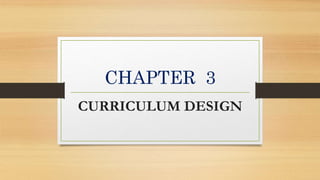
Chapter 3 Curriculum Design
- 2. DEFINITION OF CURRICULUM DESIGN • Curriculum design refers to the arrangement of the elements of a curriculum. • The four elements of a curriculum are the aims, goals, and objectives; subject matter or content; learning activities; and evaluation.
- 3. TWO MACRO & MICRO LEVEL OF OTGANIZING CURRICULUM CONTENTS • The Macro level deals with arranging or organizing the total curriculum form the philosophy down to the contents of different subjects. • The Micro level on the other hand deals with organizing the content of a specific subject of discipline. • Marco level can be referred to function of curriculum design while the micro level is a function of curriculum organization.
- 4. Four Different Curriculum Designs 1. Subject-centered designs. Majority of the curricula used in schools are arranged or organized in terms of subjects. Thus, the subject- centered designs is the most popular among the four types of curriculum designs.
- 5. A. Subject design. The curriculum is organized in terms of subjects like Mathematics, Science, Filipino, English, and other subjects. Most of the subjects are offered in elementary level. Math Science Filipino English
- 6. B. Academic discipline design. Like the subject design, the type of design organizes the curriculum in terms of discipline like Algebra, Physics, Chemistry, Literature, Economics, Philippine History, and other disciplines. This type of design is mostly used in high school and college. Biology EconomicsAlgebra Earth Science
- 7. C. Integrated design. This curriculum design is based on the principle that learners learn in an integrated manner. Thus this type of curriculum design tries to merge two or more related subjects. Basically, there are three types of integration;
- 8. i. Interdisciplinary- includes the merging of two related disciplines or subject. An example is the integration of science and health. Science Health
- 9. ii. MultiDisciplinary or Broad Fields- inludes the integration of three or more relative disciplines. An example is the Social Studies curriculum. This subject integrates Civics, History, Geography, and Economics. Civics Economics History Geography
- 10. ii. Core – requires that all subjects or discipline in the school curriculum be put together using single theme. Usualy this type of integrated curriculum design is used in preschool where subjects are combined using curriculum themes. THEME “My Family”
- 11. 2. Learner-centered designs. Learner-centered designs focus on the needs, nature, and interests of the learners in the curriculum. The aim of these design is to develop the potential and the abilities of the learners and to make the curriculum relevant and responsive to them
- 12. a. Activity/experience design. This concentrates on activities that are meaningful and interesting to the learners. In doing these activities, learners will develop various skills like process skills, communication skills, problem-solving skills critical thinking skills, and creativity that are important for the learners. b. Humanistic design. The curriculum is composed of topics and learning experiences thatfocus on the holistic development of an individual. It also addresses the needs and nature of the learners. The goal of this design is the development of a well-rounded individual
- 13. 3. Problem-centered design. These curriculum design focus on understanding and finding solution to individual and social issues and problems.
- 14. a. Thematic design. This design suggest the thematic approach to integration. Almost all models advocate this approach. The only thing that is different is the main focus of the theme. b. Problem design. The learners are exposed to the different lessons in problem solving involving real life problems.
- 15. 4. Core learning designs. These curriculum designs focus on learning a set of common subjects, disciplines, courses skills or knowledge that is necessary for students to master.
- 16. a. Core design. This is a set of common subjects, disciplines, or courses that are required for students to study before they graduate or move to the different level. b. National core curriculum design. This is a set of subjects or courses that are required to be taught to all students across the country. The national core curriculum is prescribed by the state through the DepEd or the CHED.
- 17. Things to Consider in Designing Curriculum • 1. Horizontal organization – often referred to as the scope and horizontal integration that is concern with the arrangement of curriculum components at any point in time. • 2. Vertical organization – focuses on the spiral progression of curriculum contents. For example, the skills, concept, and values that should be taught in science from Grade I to Grade VI.